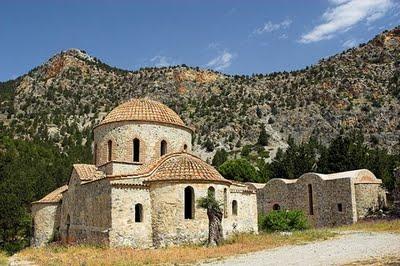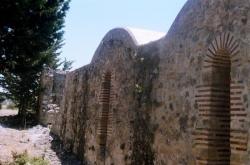PATRIMUNDIA The Cultural Heritage of North Cyprus
MONASTERY OF PANAGIA APSINTHIOTISSA
PANAGIA APSINTHIOTISSA
N° 63 a
Town / Village : Sychari / Kaynakköy
District : Kyrenia
DESCRIPTION :
About a mile of the village are the remains of the ruined monastery of Panagia Apsinthkiotissa or Apsinthiotissa.
The church of the monastery is the only hexagonal church in all of Cyprus, and was built in the late 11th century. During the late 14th century the church was ready to collapse, so internal supports and arches were build to support the dome and the apse. An orthodox church with narthex consisting of two apses on south and north sides. Octogonal pylasters support groined cross vault. Boss with relief cross. Also pylasters for statues on sides of the north apse. North and south cross vaults are missing. Incised and Plan nave with dome. Apse with secondary niches on either side. Two steps to altar space on raised floor. Refectory one nave with apse four transverse barrel vaults. There are fragments of paintings (12th – 14th century) and in the apse of the north aisle is the broken tombstone of a woman in 15th century costume.
Ruins of an earlier Byzantine chapel with an arched doorway and fallen round arch on left of entry. Square space, possibly domed. Gothic narthex older than nave.
The dining room of the monastery is unique in Cyprus, with measurements of 20 by 5 and leads to an apse, as are usually the dining rooms of Byzantine monasteries. The monastery had also murals dating to the 12th – 14th century.
In the 18th century the monastery was abandoned.
Period : 11th century – 15th century
OUTSTANDING VALUE :
The monastery of Panagia Apsinthkiotissa or Apsinthiotissa, the property of the Orthodox See of Jerusalem, is one of the most important monasteries of the Byzantine period in Cyprus, known in the Middle Ages as the Abbay of Abscithi.
MAPS / LINKS
DOCUMENTS / BIBLIOGRAPHY
According to local tradition, the monastery was named after a bush, the absinthia (wormwood) that covered very well the mouth of the cave in which a monk has hid the icon of the Virgin Mary in order to save it from the destructive fury of the iconoclasts. Many years later, with the restoration of the icons, the inhabitants of the surrounding area saw a strange light shining from this point of the mountain. They found the icon and built just below a monastery .
PHOTOS / VIDEOS
NEWS / THREATS
Parts of the frescoes decorating the church which were brutally removed, were identified in the antique markets of Europe.
ADVERTS :
3 cookbooks with a spécial gift
Make a free website with emyspot.com - Report abuse

























